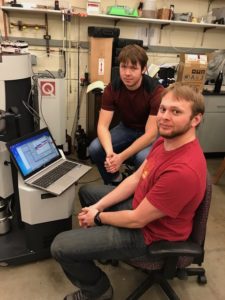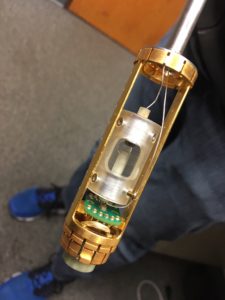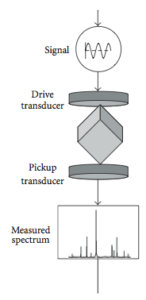 While most undergraduate students only dip their toes in the vast waters of their majors, third-year and recent graduate of the College of Natural Sciences’ Department of Physics Andrew Sexton and Aaron Glock have taken the plunge.
While most undergraduate students only dip their toes in the vast waters of their majors, third-year and recent graduate of the College of Natural Sciences’ Department of Physics Andrew Sexton and Aaron Glock have taken the plunge.
Last spring, Glock became an undergraduate researcher for the Frustrated and Quantum Magnetism group, led by Kate Ross, assistant professor in the Department of Physics. He was joined this spring by Sexton, and they’ve both become valuable assets to the group’s mission of exploring the effects of quantum mechanics on magnetic systems, which is in pursuit of discovering the theoretical quantum spin liquid state.
A humble beginning
Sexton and Glock got to know each other while doing homework in the physics undergraduate study room two years ago. Nowadays, you can find them both hard at work in a borrowed laboratory nestled deep in the heart of the Engineering Building. It’s here that they conduct experiments that push the boundaries of our current understanding of the elastic properties of magnetic materials.
Glock approaches the research with an open mind. “I’m probably only understanding a fraction of what’s going on,” said Glock. “but everyone can do it. You just have to stop telling yourself that it’s hard.”
The two have been working together to develop and test a probe known as a resonant ultrasound spectroscopy insert, designed to measure the vibrational frequencies of magnetic materials in extreme environments. This probe is one of the group’s many experimental approaches to studying the materials made in Ross’s lab.
“I’ve been really happy with what Aaron and Andrew have been doing,” Ross said. “They work really well together, and I’ve been really impressed with how much progress they’ve made. It’s been really fun to watch.”
Research in action
 To test a material, a sample is positioned between the probe’s two transducers and placed into a machine called a Physical Property Measurement System. This machine subjects the sample to magnetic fields up to nine Tesla and temperatures as low as two Kelvin.
To test a material, a sample is positioned between the probe’s two transducers and placed into a machine called a Physical Property Measurement System. This machine subjects the sample to magnetic fields up to nine Tesla and temperatures as low as two Kelvin.
An electrical signal is sent through the first transducer, causing it to vibrate at a particular frequency. As the frequency changes, the sample responds in a sequence of resonant peaks. The other transducer picks up these vibrations, which provide valuable insight into the elastic energy of the sample.
“This technique is extremely useful for all sorts of applications,” said Ross. “In our case, the quantum side of things, the applications are much harder to envision. But that’s what makes it so exciting, it’s so different from any possible technology that we already have.”
One such application exists in the field of superconductivity. Current superconductors are materials that provide exactly zero electrical resistance – but only when cooled to below a certain temperature. This new research brings scientists one step closer to discovering materials that behave as superconductors at room temperature. These materials could minimize energy loss by replacing the inefficient materials used to transmit power in today’s devices.
Harnessing undergraduate curiosity
Undergraduate research adds much more than just a line on a resume for students like Sexton and Glock. The experience they gain sets them apart from their peers and gives them the tools to succeed in any field.
“I think that undergraduates should get involved with research as soon as they can,” said Glock. “That way, they’ll have much more experience when they graduate.”
The faculty appreciate the students’ work as well. “It’s really fun to work with undergrads,” Ross said. “They always come in with this really inquisitive attitude. A lot of time, the theory of the research is a little bit beyond what they’ve studied, so it’s kind of a leap of faith for them. And they’re learning a lot by doing it.”
Through research with Ross’s lab, Sexton and Glock have learned how to code, practiced soldering, navigated electrical components, and created parts in the Physics Machine Shop. They’ve also gained experience working on long-term projects, troubleshooting and responding to failures – all while receiving invaluable mentorship from research faculty.
“The professors were once undergrads, so they completely understand,” Glock said. “It may seem intimidating if the research is far beyond your understanding, but you’re not the one with the Ph.D., so that really isn’t your job. If you think you’ve decided which professor to work for, then talk to him or her or to students in the same research group to know what kind of work you’ll be doing.”
For more information about how to get involved with undergraduate research, contact Melissa Edwards, associate director of the Office for Undergraduate Research and Artistry: Melissa.Edwards@ColoState.edu.